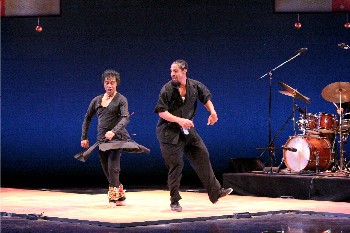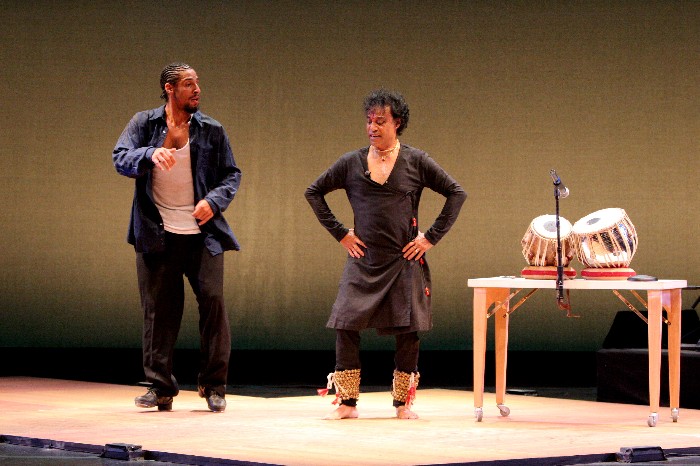Dance Review — India Jazz Suites, Where Kathak and Tap Meet
While jazz and classical Hindustani music, tap and kathak, share a number of striking elements, the collaboration presented in India Jazz Suites is not about “fusion.”
India Jazz Suites: Kathak Meets Tap. Pandit Chitresh Das & Jason Samuels Smith. Presented by World Music/CRASHarts at the Institute For Contemporary Arts/Boston, April 20 through 22.
By Ian Thal

Pandit Chitresh Das and Jason Samuels Smith in India Jazz Suites. It is not about fusion, but an artistic meeting of different dance traditions.
Dancers Pandit Chitresh Das and Jason Samuels Smith first crossed paths in 2004 backstage at a dance festival. An instant camaraderie developed into a challenging dialogue about their respective art forms, kathak and tap. The collaboration resulted in India Jazz Suites: Kathak Meets Tap. The piece first played in Boston two years ago; it returned earlier this week to the Institute of Contemporary Art.
Though the idioms of kathak and tap dance have radically different origins on separate continents, both share features that make a meeting between these two intellectually curious virtuosos particularly fruitful: both men are exemplars of traditions known for sophisticated percussive footwork, improvisation, and an intimate relationship with a rich musical tradition that also emphasizes improvisation. Just as tap dance is connected to American jazz, kathak is rooted in the classical Hindustani music of northern India.
The performance, which followed a four act structure, opened with the capable trio of Theo Hill on piano, Ryan Berg on bass, and Andrew Atkinson on drums playing modal jazz (a genre that minimizes chord progressions -— no doubt preferred because Hindustani music does not use the latter). After a musical introduction, Samuels Smith came on stage, first dancing a cappella, as if to demonstrate the dynamic and tonal range of tap shoes on the feet of a master dancer. The trio joined in, the quartet centered on developing the rapport between Smith and Atkinson, who, supplying his own sense of crowd-pleasing showmanship, matched the sounds issuing from the taps on the dance floor with a wide variety of drum techniques and implements, ranging from traditional drumsticks to brushes and timpani mallets. The collaboration also demonstrated the shared physicality of tap dancers and jazz musicians: the disciplined physical relationship between the musician and his instrument or dancer’s feet and the floor often exaggerates the idiosyncrasies of their body language.
The second act, like the first, opened with a musical trio. In this case, master tabla player Abhijit Banerjee, ghazal vocalist and harmonium player Debashish Sarkar, and sitar player Jayanta Banerjee played a raga. Like the practitioners of all of India’s classical dance forms, Pandit Das opened his performance with a pranam, a danced invocation during which the dancer pays homage to the long lineage of gurus whose teachings he reveres as well as to the divine, paying specific tribute to Shiva in his aspect at Nataraja, the cosmic dancer, and his consort Parvati. The pranam is itself a composition in which Das performed the roles of both Shiva and Parvati as well as that of the devotee, often miming such acts as the sprinkling of flower petals.
Das moved through the stages of a traditional kathak concert, demonstrating a mastery of technique and repertoire. Working within the 16-beat cycle known as tintal, Das demonstrated the different ways a dancer can subdivide the cycle. Much as Smith did with his tap shoes, Das created a gamut of tones with his bare feet and ghungru (the long string of bells traditionally wrapped around the dancer’s ankles), often in dialogue with Abhijit Banerjee’s expressive tabla.
Unlike tap, where the dancer’s body resonates with playfulness, kathak is a classical form in which every movement is in accord with a venerable canon of training: Das often punctuated a complex rhythmic motif with a sculpted stance or sometimes an ornamental turn of the wrist or raised eyebrow, micro-movements that were held until the beginning of the next phrase. This level of mastery served Das particularly well when presenting the story of King Dushyanta and Queen Shakuntala, an episode from the Mahabharata where he not only played both roles, but also the deer that Dushyanta fails to strike with his arrows and the bee that harasses Shakuntala. He even used his footwork to recreate the different gallops of the horses that pulled the king’s chariot, while simultaneously mining the sensual, mythic, and comic elements of the story. In the process, he recalled kathak’s rich history as a dance of both the temple and the princely court.
Das ended the kathak section of the evening’s program with a demonstration of one of his innovations that has become part of the pedagogy of Chhandam, the dance school he founded: kathak yoga (Disclosure: I studied for several years at Chhandika, the Boston-area affiliate of Chhandam, and have attended master classes taught by Das.) Pandit Das simultaneously danced, played tabla, and recited bols, the musical language shared by dancers and percussionists where syllables stand for specific foot or hand strokes (he explained to the audience that the yogic aspect was the meditative focus on mathematical relationships between sounds and movements). He was then joined by Smith for a third act in which they staged a largely improvised set, often quoting the dancing tradition of the other. At one point, the younger dancer performed a rap during which, perhaps echoing the elder’s opening pranam, he evoked the names of a long line of tap and jazz dancers who inspired him.
The culmination of the evening was in the fourth act: both trios of musicians returned to the stage for the title suite. The first movement featured Smith dancing with the Hindustani ensemble, a pairing that included a very charged call and response between tap shoes and Banerjee’s tabla. In contrast, the next movement presented Das dancing with the jazz trio. While the ensemble largely performed in the modal idiom of the first act, when it shifted to a blues Das adopted a shuffle rhythm quite outside of traditional kathak footwork. The final movement incorporated both trios and both dancers: each artist, both musician and dancer, stayed within their own tradition. The point being made is that while jazz and classical Hindustani music, tap and kathak, share a number of striking elements, the collaboration is not a “fusion.” Neither tradition can be fully assimilated into the other. India Jazz Suites is a “meeting” — one that hints at what can be gained by future encounters.
Tagged: Chitresh Das Dance Company, ICA, India Jazz Suites, Jason Samuels Smith, Kathak, Pandit Chitresh Das, tap


